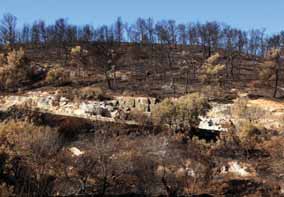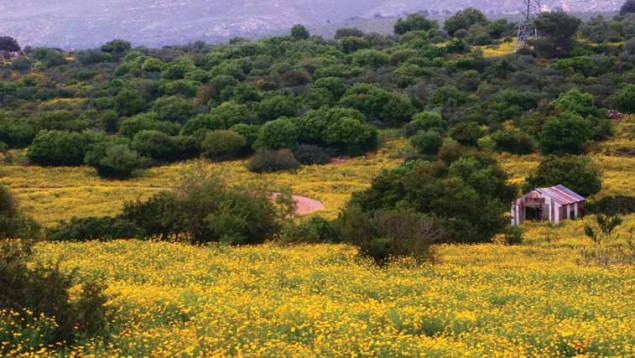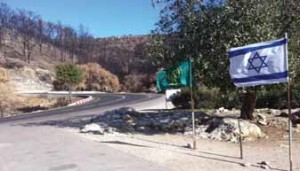 The Carmel Forest: before and after the devastating fire–the worst in Israel’s history–that claimed the lives of more than forty people. Photos: www.sasson-photos.com
The Carmel Forest: before and after the devastating fire–the worst in Israel’s history–that claimed the lives of more than forty people. Photos: www.sasson-photos.com
“And the fire of Hashem descended and consumed the elevation offering and the wood, and the stones, and the earth; and it licked up the water in the trench” (I Kings 18:38).
In late November, my wife and I drove through the Carmel Mountain Range. Throughout the forested hills, there are wonderful vantage points overlooking the Jezreel Valley, where tour guides frequently stop to tell the story of the dramatic confrontation between Eliyahu HaNavi and the prophets of the Ba’al (I Kings). We could hardly have imagined that only a week after our trip, the region would be consumed by a devastating fire—the worst in Israel’s history—that would bring firefighters from all over the world to help control the blaze.
I returned to the Carmel Range after the fire to see the devastation firsthand. The view was shocking. Millions of trees were destroyed, and nearly 8,000 acres of woodlands were singed. Much of what was green had been transformed into black, with charred skeletons of what had once been verdant trees reaching up against blue skies. Lush areas that we had walked through only a few days earlier were devastated and bleak. Road 721, which connects Atlit with Beit Oren and Damon Junction five miles away on the crest of the Carmel Range, passes through the heart of the devastation. At spots along the road, one side is black and the opposite side is green. There is also a hastily constructed memorial to the forty-three people—most of whom were Israel Prison Service officers—who tragically perished when the bus they were traveling in was suddenly engulfed by flames.
And yet, large areas of forest were miraculously untouched by the surging fire. Many of the lookout points, picnic groves and Jewish National Fund facilities (public bathrooms) are still readily accessible and completely undamaged.
The Book of Kings describes the failure of the prophets of Ba’al to invoke their gods to consume their sacrifice. The Navi then depicts Eliyahu HaNavi’s triumph when God responds with a great fire that consumes his sacrifice and scorches everything within sight. The chapter concludes with a rainstorm—God’s response to Eliyahu HaNavi’s prayers for rain, ending a period of severe drought.
There are many appropriate places for feeling the power of the narrative in the Book of Kings, each with magnificent views of the Jezreel Valley and the Haifa/Acco region. One of the most spectacular of these places is Muhraka (“place of the burning” in Arabic), two and a half miles to the south of Damon Junction on Road 672, and just beyond the Druze village of Isufia. It was on this summit, almost 500 meters above sea level and the second highest spot in the region, that God’s fire descended to consume Eliyahu HaNavi’s sacrifice. Today, a monastery occupies the spot on the crest of the hill, but a short path, beginning on the left side of the parking lot, takes you to a magnificent lookout point. In the distance to the east, across the Jezreel Valley, the domed peak of Mount Tabor prominently rises, bringing to mind another famous story from the Book of Judges: the great victory of Devorah over the Canaanites.
Another spot with a view to the north is called Givat HaHaganah. From Damon Junction, travel approximately three quarters of a mile on Road 672. Look for a small brown sign on the right, in Hebrew. Follow the dirt road a few hundred meters to a parking lot and then continue on foot to a large basalt stone with the symbol of the Haganah carved into it. You are in the midst of a lovely picnic grove, unscathed by the fire. This is a wonderful spot to have your lunch (there are facilities), admire the view and simply relax in the shade. The spectacular view is of Haifa, and along the Mediterranean coast, of Acco and Rosh Hanikra and of the hills of Lebanon in the distance.
Visiting the Nisco Museum of Mechanical Music (http://www.ein-hod.info/nisco/) in the artist’s village of Ein Hod is a must. Upon making aliyah fifteen years ago, eighty-four-year-old Nisan Cohen brought with him a unique collection of music boxes and other devices, which he had collected over forty years. Gathering and lovingly restoring these historic music boxes—some from the mid-nineteenth century—has been Cohen’s life work. He opened a museum, which, until the fire, delighted countless children and adults alike. During my visit to the museum, prior to the fire, Nisan proudly showed me treasures of a bygone era—including a working gramophone from the time of Thomas Edison and a player piano, the keys mysteriously going up and down to accompaniment of a classic master. What a dramatic contrast to today when music emanates from a microchip on an iPod!
Tragically, the fire destroyed many of the precious, irreplaceable items in the museum. What the flames didn’t reach, the intense heat did, melting wax and warping metal. Yet, with incredible hope and optimism, and with the generous assistance of friends all over the world, Nisan has been working tirelessly to restore the music boxes and to rebuild the museum. When I revisited him a few weeks after the fire, he told me, with a twinkle in his eye, that he hoped to reopen in March 2011. By the time this article appears, tourists should once again be able to visit this magical museum and experience the delightful marvels of a bygone era. Call first (052.475.5313) or send an e-mail to niscomuseum@bezeqint.net. You will be in for a unique and memorable treat!
The Carmel Mountain area can be easily reached from the coastal highway (Route 2), Atlit Interchange, from the old Tel Aviv Haifa road (Route 4) or from
the road that leaves the upper neighborhoods of Haifa (the Hadar) in the direction of Haifa University and Damon Junction.
Just as in the narrative involving Eliyahu and the prophets of Ba’al, the fire of December 2010 was followed by a rainstorm, the first one in Israel this year and a welcome relief for the parched country. As spring approaches, the first small shoots of green are beginning to emerge from the blackened earth of the Carmel forest—signs of rebirth, renewal and hope.
Peter Abelow is a licensed tour guide and associate director of Keshet: The Center for Educational Tourism in Israel. Keshet specializes in creating and running inspiring family and group tours that make Israel come alive “Jewishly.” He can be reached at 011.972.2.671.3518 or at peter@keshetisrael.co.il

